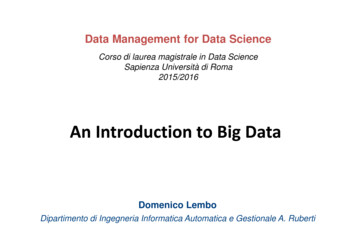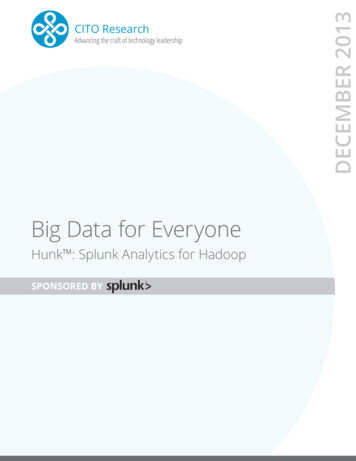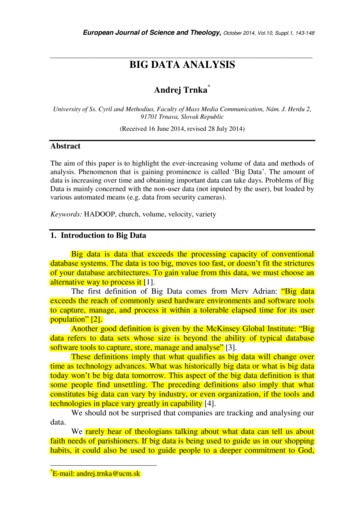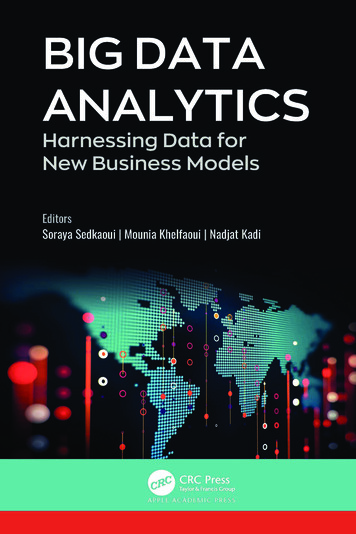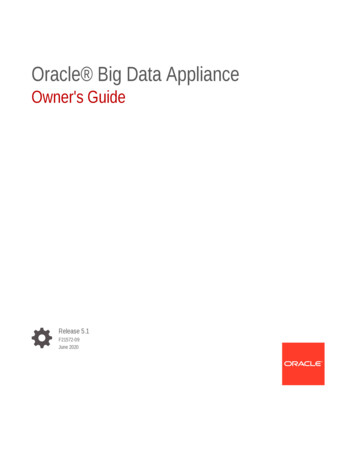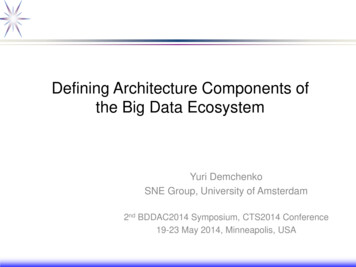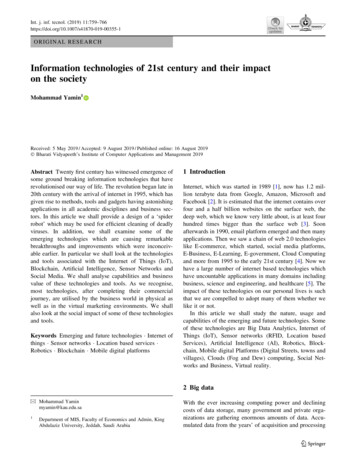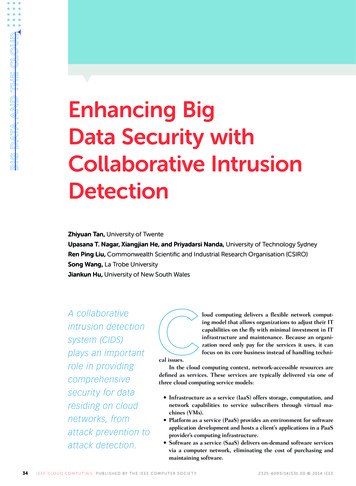
Transcription
Big Data and the CloudEnhancing BigData Security withCollaborative IntrusionDetectionZhiyuan Tan, University of TwenteUpasana T. Nagar, Xiangjian He, and Priyadarsi Nanda, University of Technology SydneyRen Ping Liu, Commonwealth Scientific and Industrial Research Organisation (CSIRO)Song Wang, La Trobe UniversityJiankun Hu, University of New South WalesA collaborativeintrusion detectionsystem (CIDS)plays an importantrole in providingcomprehensivesecurity for dataresiding on cloudnetworks, fromattack prevention toattack detection.34loud computing delivers a flexible network computing model that allows organizations to adjust their ITcapabilities on the fly with minimal investment in ITinfrastructure and maintenance. Because an organization need only pay for the services it uses, it canfocus on its core business instead of handling technical issues.In the cloud computing context, network-accessible resources aredefined as services. These services are typically delivered via one ofthree cloud computing service models: Infrastructure as a service (IaaS) offers storage, computation, andnetwork capabilities to service subscribers through virtual machines (VMs). Platform as a service (PaaS) provides an environment for softwareapplication development and hosts a client’s applications in a PaaSprovider’s computing infrastructure. Software as a service (SaaS) delivers on-demand software servicesvia a computer network, eliminating the cost of purchasing andmaintaining software.I E E E C l o u d C o m p u t i n g p u b l i s h e d b y t h e I E E E c o m p u t e r s o cie t y 2325- 6095/14/ 31 .0 0 2014 IEEE
These technical and business advantages, however, don’t come without cost. The security vulnerabilities inherited from the underlying technologies (thatis, virtualization, IP, APIs, and datacenter) preventorganizations from adopting the cloud in many critical business applications.1 Generally speaking, cloudcomputing is a service-oriented architecture (SOA).Earlier work gives a comprehensive dependability andsecurity taxonomy framework revealing the complexsecurity cause-implication relations in this architecture.2 We summarize cloud computing vulnerabilitiesby underlying technology in the sidebar.These vulnerabilities leave loopholes, allowingcyberintruders to exploit cloud computing services and threatening the security and privacy of bigdata. Various security schemes, such as encryption,authentication, access control, firewalls, intrusiondetection system (IDSs), and data leak preventionsystems (DLPSs), address these security issues. Inthis complex computing environment, however, nosingle scheme fits all cases. These schemes shouldthus be integrated and cooperate to provide a comprehensive line of defense.Intrusion Detection for Securing CloudComputingIDSs aim to provide a layer of defense against malicious uses of computing systems by sensing attacksand alerting users. Because it’s impossible to preventall cyberattacks, IDSs have become essential to securing cloud computing environments.IDSs are commonly categorized by the type ofdata source involved in detection. Host-based IDSs(HIDSs) detect malicious events on host machines.They handle insider attacks (which attempt to gainunauthorized privileges) and user-to-root attacks(which attempt to gain root privileges to VMs or thehost). Network-based IDSs (NIDSs) monitor andflag traffic carrying malicious contents or presenting malicious patterns. This type of IDS can detectdirect and indirect flooding attacks, port-scanningattacks, and so on.Although to some extent, DLPSs can be considered a type of IDS, they’re more tailored to data security. However, it’s difficult to completely guaranteedata security using DLPSs alone. Attackers who gaincontrol of the host machines can modify the DLPSsettings, thereby completely disclosing data to thoseSe p t e m b e r 2 0 1 4attackers. Moreover, even though firewalls can blockunwanted network traffic packets according to a predefined rule set, they can’t detect sophisticated intrusive attempts such as flooding and insider attacks.IDSs, DLPSs, and firewalls are therefore not interchangeable security schemes but collaborative ones.Conventional IDSsConventional IDSs are mostly standalone systems residing on computer networks or host machines. Theycan be categorized as misuse-based or anomalybased IDSs, depending on the detection mechanismapplied.Misuse-based IDSs enjoy high detection accuracy but are vulnerable to all zero-day intrusions.3This is due to the underlying detection mechanismthat checks for a match with existing attack signatures. Obviously, an IDS can’t generate signaturesfor an unknown attack. Anomaly-based IDSs showpromise for detecting zero-day intrusions,4,5 but areprone to high false positives.Current enterprise networks (such as cloudcomputing environments) typically have multipleentry points. This topology is intended to enhance anetwork’s accessibility and availability, but it leavessecurity vulnerabilities that sophisticated attackerscan exploit using advanced techniques, such as cooperative intrusions.Unlike traditional attack mechanisms, cooperative attack mechanisms are launched simultaneously by slave machines within a botnet. Attackersorganize instances of this attack type to penetratean enterprise network through all its entry points.By evenly distributing the attack traffic volume tothe different entry points, these cooperative intrusions can evade detection of traditional standaloneIDSs set in front of the entry points. This is because network traffic behavior at each entry pointdoesn’t significantly deviate from normal behavior.After traveling through the entry points, the attackinstances are directed to a single targeted servicewithin the enterprise network.Moreover, many of the existing intrusions canoccur collaboratively and simultaneously on nodesthroughout a network. Attackers can initiate automated attacks targeting all vulnerable services within a network simultaneously,6 rather than focusingon a specific service.I EEE Clo u d Co m p u t i n g 35
Big Data and the CloudVulnerabilities in UnderlyingTechnologiesulnerabilities in the cloud’s underlying technologies allow cyberintrudersto exploit cloud computing services andthreaten the security and privacy of big data.VirtualizationVirtualization facilitates multitenancy and resource sharing (such as physical machines andnetworks) and enables maximum utilizationof available resources. Categories include full,OS-layer, and hardware-layer virtualizations.Virtual machines (VMs) can gain full accessto a host’s resources if isolation between thehost and the VMs isn’t properly configured andmaintained. (In this case, the VMs escape tothe host and seize root privileges.) In addition,a VM’s security can’t be guaranteed if its hostis compromised. Hosts and their VMs sharenetworks via a virtual switch, which VMs coulduse as a channel to capture the packets transiting over the networks or to launch AddressResolution Protocol (ARP) poisoning attacks.Finally, because a host shares computingresources with its VMs, a guest could launcha denial-of-service (DoS) attack via a VM bytaking up all the host’s resources.IP SuiteThe IP suite, the core component of theInternet, ensures the functioning of internetworking systems and allows access toremote computing resources.Need for Collaborative Intrusion DetectionConventional standalone IDSs are susceptible tocooperative attacks, so are unsuitable for collaborative environments (such as a cloud computing environment). To defend against this type of attack,collaborative intrusion detection systems (CIDSs)correlate suspicious evidence between differentIDSs to improve the intrusion detection efficiency. Unlike conventional standalone IDSs, a CIDS36Defects in the implementation of theTCP/IP protocol suite can lead to a variety ofattacks, including IP spoofing, ARP spoofing,DNS poisoning, Routing Information Protocol (RIP) attacks, flooding, HTTP session riding, and session hijacking.Application Programming InterfacesAPIs provide interfaces for managing cloudservices, including service provisioning,orchestration, and monitoring. Areas ofvulnerability include weak credentials,authorization checks, and input-data validation, which could allow an attacker to seizeroot privileges. Developers might introducedefects during the design and implementation of cloud APIs or introduce new securityvulnerabilities when fixing bugs.DatacenterDatacenter technologies allow administrators to manage and store data. Data is oftenstored, processed, and transferred in plaintext, which can be compromised, leading to the loss of confidentiality. Attackersmight also find residual data from datathat’s been deleted. Finally, in a datacenter,data from different users (both legitimateusers and intruders) is mixed together withweak separation, providing opportunitiesfor an intruder to access the data of thelegitimate users.shares traffic information with the IDSs located at alocal network’s entry points.In practice, we can organize IDSs within aCIDS in a decentralized7 or hierarchical8 mannerover a large network. These IDSs communicate directly with each other or with a central coordinator,according to the applied mode of organization.In a decentralized CIDS, each IDS can generate a complete attack diagram of the network by ag-I EEE Clo u d Co m p u t i n g w w w.co m p u t er .o rg /clo u d co m p u t i n g
gregating network information received from otherIDSs in the CIDS. Detection of malicious attemptsis undertaken locally at each IDS. In a hierarchicalCIDS, a coordinator is a central point responsiblefor information aggregation. The central coordinator, which analyzes the aggregated information, generates a complete attack diagram of the network.Limitations of Current Collaborative IDSsCollaborative IDSs seem promising for detecting cooperative intrusions. However, existing system architectures aren’t without criticism. In CIDSs, networkdata summarization is an important precursor to reliable intrusion detection.9 However, traditionally, network information is collected and processed by IDSsoftware built on a single network device that onlydeals with the traffic flowing in and out of that device. It therefore has limited traffic information. Inaddition, the computation of network data summarization is proportional to the amount of traffic flowthat single device experiences. Such an approach hasdrawbacks in terms of both accuracy and efficiency.In terms of accuracy, without knowledge of thenetwork data from other nodes, any summarizationis specific to a partial and insignificant portion of allavailable data over the entire network. Exchangingand combining these summarizations later, withoutthe actual data, provides a minimal information gain.In terms of efficiency, nodes with denser trafficrequire additional computation to process summarization. Because summarization is a pure overheadoperation, in an ideal environment, a node will haveless traffic to process when performing summarization tasks.Security is another concern for existing CIDSs. If a CIDS is compromised, the entire cloudcomputing environment is in danger. ConventionalIDS software, installed on a single network device,analyzes and maintains network information on thedevice but doesn’t include security properties thatensure confidentiality, authentication, and integrity.Thus, CIDSs that are designed simply by integratingconventional IDS software without proper securityenhancements are vulnerable to attacks.Collaborative Intrusion DetectionFrameworkGiven the defects of existing CIDSs, a new sophisticated CIDS framework could strengthen the security of cloud computing systems. However, cloudcomputing presents unique issues. With a large,dense network of nodes forming a cloud environment, cloud computing offers us unprecedentedopportunities for making available network dataSe p t e m b e r 2 0 1 4from all nodes. At the same time, it requires that weperform summarization and combine the results ina distributed and parallel manner. In addition, because we’re now dealing with all the network datain the entire cloud, where an unknown number ofcategories can exist, the summarization algorithmswill need to expand their categories on demand toautomatically create new clusters when they discover new types of traffic emerging.Given the characteristics of cloud computing,we must consider several desirable properties whendesigning a new CIDS framework. These propertiesinclude fast detection of various attacks with minimalfalse positive rates, scalability with the expansion ofthe cloud computing system, self-adaption to changesin the cloud computing environment, and resistanceto compromise.10 Figure 1 shows the framework ofour proposed CIDS, which meets these requirements.As Figure 1 shows, HIDSs and NIDSs cooperate to perform intrusion detection at the host andnetwork levels, and each IDS in the network isequipped with signature- and anomaly-based detectors.11 This tactic ensures better detection accuracyin both known and unknown attacks.There are two categories of nodes in this framework—cooperative agent and central coordinator.These nodes form a collaborative system whose security is assured through the implementation of various security mechanisms.Cooperative AgentsCooperative agents stand at the front lines and detect misuses on host machines or malicious behavioron networks. These agents are equipped with HIDSsor NIDSs depending on their location—agents installed on a host machine to detect suspicious eventsare equipped with HIDSs, whereas agents monitoring traffic on a network are equipped with NIDSs.In our framework, the cooperative agents locatedon host machines are a new type of HIDS, requiringno instrumentation within VMs or models processesat the VM granularity level (that is, treating VMs asindividual processes and modeling VM behaviorsaccordingly). This scheme ensures that our detection system complies with service-level agreements(SLAs) and legal restrictions, which might not allow an IaaS provider to make amendments or perform intensive monitoring and surveillance on clientVMs. It also alleviates the ineffectiveness of NIDSson encrypted traffic. The host-based cooperativeagents inform a central coordinator when they detect an intrusive behavior or activity.Cooperative agents residing at the networklevel conduct first-tier detection, defending againstI EEE Clo u d Co m p u t i n g 37
Big Data and the lcoordinatorBackup centralcoordinatorHost machinesHost machinesHIDSCloud computing environmentHost machinesHIDSFigure 1. Framework of a collaborative intrusion detection system (CIDS). The figure illustrates how the differenttypes of fellow IDSs are deployed in a cloud computing environment, and how they cooperate with each other andcentral coordinators in detecting intrusions. (HIDS: host-based IDS, NIDS: network-based IDS)generic attacks that present abnormality within thenetwork traffic and don’t involve sophisticated cooperation. The network-based cooperative agentsalert a central coordinator to any suspicious packets detected. Meanwhile, these agents summarizenetwork traffic flowing through the network in adistributed and parallel manner. In network datasummarization, the nonparametric Bayes could bea suitable machine learning approach for solvingthe challenges of cloud computing.12 Network summarization is particularly important for detectingcooperative intrusions, such as distributed denialof-service (DDoS) attacks. These summarizationsare periodically sent to a central coordinator, as wediscuss next.This parallel summarization is empowered bycloud computing through the MapReduce framework.13 The MapReduce framework provides seamless and effortless integration of our CIDS frameworkinto a distributed and parallel architecture by treatingthe network-based cooperative agents as slave nodes38and the central coordinator as a master node. TheMapReduce framework manages all details, rangingfrom scheduling to information aggregation.Central CoordinatorFinally, the network traffic aggregation is performedon the central coordinator, which generates a complete attack diagram of the entire network (that is,the cloud computing system). Based on this aggregation, the central coordinator is capable of capturing sophisticated cooperative intrusions that theindividual network-based cooperative agents miss.When intrusive behaviors (including those identifiedby the cooperative agents and the central coordinator) are detected, the central coordinator raises analert to a system administrator.It’s worth noting that a hybrid detector combining misuse- and anomaly-based detection mechanisms can help reduce the time needed to detectand enhance the detection accuracy of known andunknown attacks.I EEE Clo u d Co m p u t i n g w w w.co m p u t er .o rg /clo u d co m p u t i n g
Security MechanismsTo ensure that the CIDS is resistant to compromise,we use authentication and encryption as well asan integrity check. Because the CIDS works 24/7,energy-efficient group key distribution schemes arepreferable for secure key distribution and node authentication.14,15 These schemes provide a strong,secure mechanism for updating group keys whennodes join in or leave the network or a node is being compromised. They’re also resilient to collusionattacks, in which multiple nodes are compromisedand coordinated for attack. Finally, a backup centralcoordinator runs alongside the main coordinator toprevent a single point of failure. The coordinators’roles can be exchanged depending on actual requirements and network conditions.uture studies will explore the framework’s implementation and application on different cloudcomputing systems. Focuses of our future studieswill be casted on algorithms for distributed and parallel data summarization on cloud computing, andtheir implementation on the MapReduce framework,as well as new detection approaches for HIDSs.AcknowledgmentsThe work described here was performed when Zhiyuan Tan was a research associate with the Schoolof Computing and Communications at the University of Technology, Sydney.References1. C. Modi et al., “A Survey on Security Issues andSolutions at Different Layers of Cloud Computing,” J. Supercomputing, vol. 63, no. 2, 2013, pp.561–592.2. J. Hu et al., “Seamless Integration of Dependability and Security Concepts in SOA: A Feedback Control System Based Framework and Taxonomy,” J. Network and Computer Applications,vol. 34, no. 4, 2011, pp. 1150–1159.3. Y. Meng, W. Li, and L.-F. Kwok, “Towards Adaptive Character Frequency-Based Exclusive Signature Matching Scheme and Its Applicationsin Distributed Intrusion Detection,” ComputerNetworks, vol. 57, no. 17, 2013, pp. 3630–3640.4. G. Creech and J. Hu, “A Semantic Approach toHost-Based Intrusion Detection Systems UsingContiguous and Discontiguous System Call Patterns,” IEEE Trans. Computers, vol. 63, no. 4,2014, pp. 807–819.5. Z. Tan et al., “A System for Denial-of-Service Attack Detection Based on Multivariate CorrelaSe p t e m b e r 2 0 1 4tion Analysis,” IEEE Trans. Parallel and Distributed Systems, vol. 25, no. 2, 2014, pp. 447–456.6. S. Savage, “Internet Outbreaks: Epidemiology and Defenses,” keynote address, InternetSoc. Symp. Network and Distributed SystemSecurity (NDSS 05), 2005; http://cseweb.ucsd.edu/ savage/papers/InternetOutbreak.NDSS05.pdf.7. S. Ram, “Secure Cloud Computing Based onMutual Intrusion Detection System,” Int’l J.Computer Application, vol. 2, no. 1, 2012, pp.57–67.8. S.N. Dhage and B. Meshram, “Intrusion Detection System in Cloud Computing Environment,”Int’l J. Cloud Computing, vol. 1, no. 2, 2012, pp.261–282.9. D. Hoplaros, Z. Tari, and I. Khalil, “Data Summarization for Network Traffic Monitoring,” J.Network and Computer Applications, vol. 37, Jan.2014, pp. 194–205.10. A. Patel et al., “An Intrusion Detection and Prevention System in Cloud Computing: A Systematic Review,” J. Network and Computer Applications, vol. 36, no. 1, 2013, pp. 25–41.11. A.K. Jones and R.S. Sielken, Computer SystemIntrusion Detection: A Survey, tech. report, Dept.of Computer Science, Univ. of Virginia, 2000;http://atlas.cs.virginia.edu/ v11.pdf.12. N. L. Hjort et al., eds. Bayesian Nonparametrics,vol. 28, Cambridge Univ., 2010.13. J. Dean and S. Ghemawat, “MapReduce: Simplified Data Processing on Large Clusters,” Comm.ACM, vol. 51, no. 1, 2008, pp. 107–113.14. B. Tian et al., “A Mutual-Healing Key Distribution Scheme in Wireless Sensor Networks,” J.Network and Computer Applications, vol. 34, no.1, 2011, pp. 80–88.15. B. Tian et al., “Self-Healing Key DistributionSchemes for Wireless Networks: A Survey,”Computer J., vol. 54, no. 4, 2011, pp. 549–569.Zhiyuan Tan is a postdoctoral research fellow inthe Faculty of Electrical Engineering, Mathematics,and Computer Science, University of Twente, Enschede, Netherlands. His research interests include network security, pattern recognition, machine learning,and distributed systems. Tan received a PhD from theUniversity of Technology Sydney (UTS), Australia. He’san IEEE member. Contact him at z.tan@utwente.nl.Upasana T. Nagar is a PhD student in theSchool of Computing and Communications at theUniversity of Technology, Sydney (UTS), Australia,I EEE Clo u d Co m p u t i n g 39
Big Data and the Cloudand a student member of the Research Centre for Innovation in IT Services and Applications (iNEXT) atUTS. Her research interests include network security,pattern recognition, and cloud computing. Nagar received a bachelor’s degree in electronics from the National Institute of Technology, Surat. Contact her atUpasana.T.Nagar@student.uts.edu.au.Xiangjian He is a professor of computer sciencein the School of Computing and Communicationsat the University of Technology, Sydney (UTS). He’salso director of the Computer Vision and RecognitionLaboratory, leader of the Network Security Researchgroup, and a deputy director of the Research Centrefor Innovation in IT Services and Applications (iNEXT) at UTS. His research interests include networksecurity, image processing, pattern recognition, andcomputer vision. He received a PhD in computer science from the University of Technology Sydney (UTS),Australia. He’s an IEEE senior member. Contact himat Xiangjian.He@uts.edu.au.Priyadarsi Nanda is a senior lecturer in theSchool of Computing and Communications at theUniversity of Technology, Sydney (UTS), Australia.He’s also a core research member at the Centre forInnovation in IT Services Applications (iNEXT) atUTS. His research interests include network security,network QoS, sensor networks, and wireless networks.Nanda received a PhD in computer science from theUniversity of Technology Sydney (UTS), Australia. He’san IEEE senior member. Contact him at Priyadarsi.Nanda@uts.edu.au.Ren Ping Liu is a principal scientist of networking technology at the Commonwealth Scientific andIndustrial Research Organisation (CSIRO) and an adjunct professor at Macquarie University and the University of Technology, Sydney (UTS), Australia. Hisresearch interests include MAC protocol design, Markov analysis, quality-of-service scheduling, TCP/IPinternetworking, and network security. Liu receiveda PhD in electrical and computer engineering fromUniversity of Newcastle, Australia. He’s an IEEE senior member. Contact him at Ren.Liu@csiro.au.Song Wang is a senior lecturer with the Department of Electronic Engineering, La Trobe University,Melbourne, Australia. Her research interests includebiometric security, blind system identification, andwireless communication. Wang received a PhD inelectrical and electronic engineering from the University of Melbourne. Contact her at song.wang@latrobe.edu.au.Jiankun Hu is a full professor and research director of the Cyber Security Lab, School of Engineeringand IT, University of New South Wales at the Australian Defence Force Academy, Canberra, Australia.His research interests are in the field of cybersecurityincluding biometrics security. Hu received a PhD incontrol engineering from Harbin Institute of Technology, China. He’s an IEEE member. Contact him atj.hu@adfa.edu.au.Selected CS articles and columns are also availablefor free at http://ComputingNow.computer.org.40I EEE Clo u d Co m p u t i n g w w w.co m p u t er .o rg /clo u d co m p u t i n g
via a computer network, eliminating the cost of purchasing and maintaining software. A collaborative intrusion detection system (CIDS) plays an important role in providing comprehensive security for data residing on cloud networks, from attack prevention to attack detection. Big Data an D the Clou D




